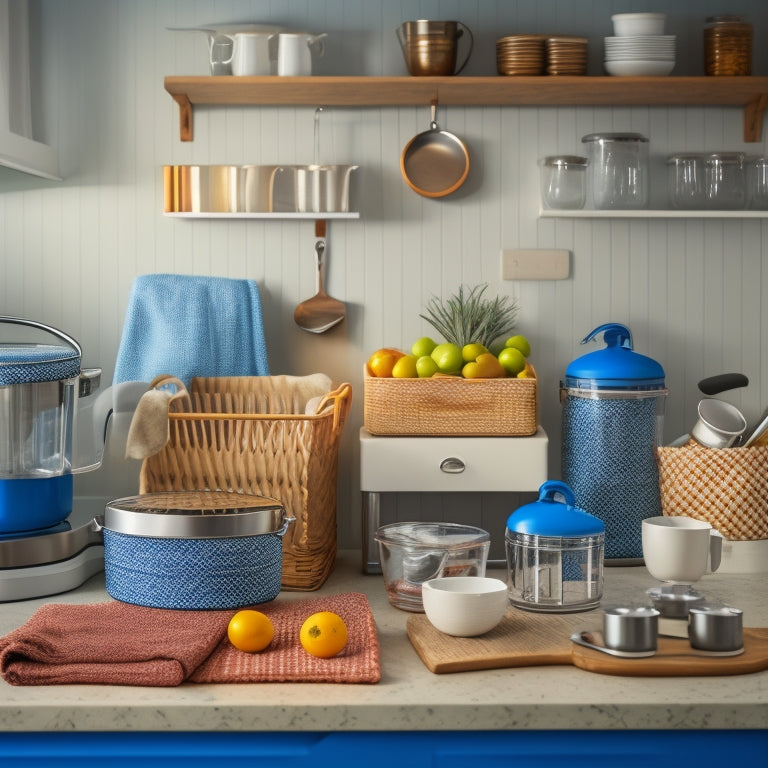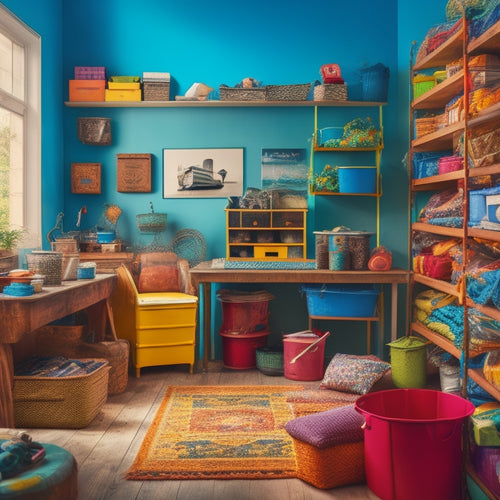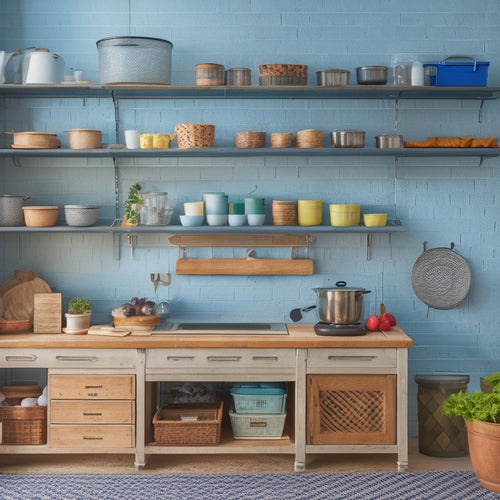
7 Steps to Organize Your Kitchen Countertops
Share
You're taking the first step towards altering your kitchen countertops into a haven of efficiency and control. To get started, purge unnecessary items, categorizing them into keep, donate/sell, and discard piles. Next, group essentials by task, designating specific zones for cooking, cleaning, and more. Make the most of vertical storage, labeling, and implementing a "one in, one out" rule to maintain balance. By following these 7 steps, you'll be well on your way to a clutter-free, organized kitchen where every item has its designated home. Now, uncover how each step can be customized to fit your unique kitchen needs.
Key Takeaways
- Purge unnecessary items by categorizing them into keep, donate/sell, and discard to declutter countertops and maintain a minimalist approach.
- Designate zones for tasks like food preparation, cooking, and cleaning to improve workflow and reduce time spent searching for utensils or ingredients.
- Implement a "one in, one out" rule to manage kitchen gadgets and maintain a balanced number of functional, high-quality essentials.
- Utilize vertical storage space by installing wall-mounted racks and hanging baskets to clear countertops and reserve lower shelves for daily essentials.
- Label and sign everything to ensure designated homes for every kitchen item, aid in quick identification, and create a cohesive look.
Purge Unnecessary Kitchen Items
Most of the clutter on your kitchen countertops is likely due to unnecessary items that haven't been used in months or even years.
It's time to take control and purge these items. Start by taking everything off your countertops and sort items into three piles: keep, donate/sell, and discard.
Be honest with yourself - when was the last time you used that appliance or gadget? If it's been a while, consider letting it go.
By implementing a structured filing system digital solutions and optimizing your kitchen layout, you'll be able to focus on what's truly essential.
Taking a minimalist approach to your kitchen inventory will help you focus on what's truly essential.
Categorize Kitchen Essentials
You've purged your kitchen countertops of unnecessary items, and now it's time to categorize the essentials that remain.
Take stock of your kitchen inventory and group similar items together. Essential tools like knives, cutting boards, and utensils should be separated from cooking vessels, baking supplies, and appliances.
Consider the frequency of use and categorize your items accordingly. Daily use items, like your favorite coffee mug, should be easily accessible, while less frequently used items, like special occasion dishes, can be stored away.
Designate Zones for Tasks
Regularly, you'll find yourself performing specific tasks in the kitchen, and designating zones for these tasks will optimize your workflow and reduce clutter. By assigning a specific area for each task, you'll improve task efficiency and reduce the time spent searching for utensils or ingredients. Create zones for common tasks like food preparation, cooking, and cleaning to maintain a sense of control and organization.
| Task Zone | Essential Items |
|---|---|
| Food Prep | Cutting board, knives, utensils, bowls |
| Cooking | Stove, oven, pots, pans, cooking utensils |
| Cleaning | Sink, soap, scrubbers, trash can, cleaning supplies |
| Baking | Stand mixer, baking sheets, utensils, ingredients |
| Coffee Station | Coffee maker, coffee, sugar, creamer, mugs |
Utilize Vertical Storage Space
Kitchen countertops can quickly become cluttered, making it difficult to focus on the task at hand. To maximize your kitchen's potential, you need to think vertically.
Installing wall-mounted racks and hanging baskets will help you make use of the often-wasted space above your countertops. This won't only keep your countertops clear but also provide easy access to frequently used items.
You can store infrequently used items, like special occasion dishes or cookbooks, on higher shelves, reserving lower shelves for daily essentials. By doing so, you'll create a more streamlined kitchen that lets you work efficiently and stay in control.
Implement a "One In, One Out" Rule
You're probably guilty of buying new kitchen gadgets without getting rid of old ones, and that's why your countertops are cluttered.
To maintain your newly organized space, adopt a "one in, one out" rule, where you declutter before buying, replace old items with new ones, and limit the number of gadgets you keep.
Declutter Before You Buy
Your countertops are a reflection of your daily habits and cooking style, and it's easy to let clutter accumulate when you're not mindful of what you're bringing into your kitchen. Before buying new kitchen essentials, take a step back and assess what you already have. Implement a "one in, one out" rule to maintain a balanced amount of items on your countertops.
| Category | Keep | Let Go |
| Kitchen Gadgets | Stand mixer, immersion blender | Unused food processor, broken appliances |
| Cooking Utensils | Favorite spatula, silicone spoons | Duplicate or low-quality items |
| Decorations | A few decorative pieces that enhance countertop aesthetics | Cluttered or outdated decorations |
Replace Old With New
Now that you've purged your countertops of unnecessary items, it's time to replace old or low-quality essentials with new ones that will enhance your cooking experience.
Implement a "one in, one out" rule to maintain your newly organized space. When bringing in modern appliances, consider their functionality and durability.
Upgrade to high-quality countertop materials that are easy to clean and maintain. This will create a cohesive look and make meal prep a breeze.
Replace worn-out utensils and gadgets with new ones that align with your cooking style. By doing so, you'll create a kitchen that's both functional and visually appealing.
Limit Kitchen Gadgets
As you start to restock your kitchen with new essentials, it's important to maintain a balanced approach to avoid clutter buildup. You don't want to end up with a countertop that's overcrowded with gadgets.
Implement a "one in, one out" rule to guarantee that every new gadget you bring in replaces an old one. Be intentional with your gadget selection, opting for functional design and multi-purpose items. This will help you avoid duplications and keep your countertops organized.
Label and Sign Everything
You'll find that a clear labeling system helps you quickly identify what's inside containers and cabinets, saving you time and frustration.
By assigning a specific storage space to each item, you'll guarantee everything has a designated home, making it easier to maintain your organized kitchen.
With labeled containers and assigned spaces, you'll be able to see at a glance where everything belongs.
Clear Labeling System
By implementing a clear labeling system, you'll be able to quickly identify what's inside containers and cabinets, saving time and reducing frustration in the kitchen. This system helps you maintain organized containers and guarantees everything has its designated place. Use a consistent labeling method, such as stickers or chalkboard labels, to create a cohesive look.
| Category | Label Color | Example |
|---|---|---|
| Baking Supplies | Yellow | Flour, Sugar, Baking Powder |
| Cooking Essentials | Red | Olive Oil, Salt, Pepper |
| Snacks | Green | Granola, Nuts, Dried Fruits |
Assigned Storage Spaces
Every item in your kitchen deserves a designated home, and assigned storage spaces guarantee that everything stays in its place.
By designating specific areas for kitchen storage, you'll maintain organized spaces and avoid clutter.
Label each storage space with its contents, so you and others can easily identify where items belong.
Signage can be as simple as a handwritten note or a decorative label.
This system ensures that everyone puts things back in their assigned spot, keeping your kitchen countertops clutter-free.
With assigned storage spaces, you'll save time searching for misplaced items and enjoy a more efficient cooking experience.
Maintain Your New System
Establishing a new system for organizing kitchen countertops is only half the battle; sustaining it requires commitment and dedication.
To maintain your newly organized kitchen, you'll need to establish habits that promote cleanliness and order.
- Set aside time each day to wipe down countertops and tidy up clutter.
- Create a weekly schedule for deeper cleaning tasks, such as sanitizing sink basins and stove tops.
- Implement a "one-touch rule" for kitchen items, putting them away in their assigned storage spaces immediately after use.
- Regularly assess your kitchen maintenance tips and countertop cleaning routines to identify areas for improvement.
Frequently Asked Questions
How Do I Decide What Kitchen Items to Keep or Discard?
You'll decide what kitchen items to keep or discard by identifying your kitchen essentials and applying decluttering strategies, like the "one in, one out" rule, to guarantee you're only holding onto items that serve a purpose or bring you joy.
Can I Still Have Decorative Items on My Countertops?
As you curate your kitchen's visual harmony, you're wondering if decorative items can still shine on your countertops. Absolutely, you can strike a decorative balance that blends functional aesthetics with personal style, as long as they don't clutter your workflow.
Are There Any Specific Zones I Should Designate for Tasks?
When designing your workspace, you'll enhance task efficiency by designating specific zones for tasks, optimizing your workflow, and strategically placing tools and ingredients to minimize walking distances, allowing you to focus on cooking, not chaos.
How Often Should I Clean and Maintain My Countertops?
You're not alone in your cleaning concerns: 80% of Americans prioritize kitchen cleanliness. To maintain your countertops, consider the material: daily wiping for granite, weekly scrubbing for stainless steel, and bi-weekly deep cleans for butcher block.
What if I Have Limited Space for Vertical Storage Solutions?
When you're short on space for vertical storage, you're not out of options; consider space-saving ideas like under-sink shelves, hanging utensil holders, or countertop alternatives like a wall-mounted pot rack to maximize your kitchen's potential.
Related Posts
-

What Are the Best DIY Storage Hacks Online?
You're looking for the best DIY storage hacks online! You've come to the right place. From repurposing old pallets an...
-

Mastering Closet Organization With Digital Tools
You're ready to tame the chaos in your closet, and digital tools are here to help. Start by accessing online tutorial...
-

10 Budget-Friendly DIY Kitchen Space Hacks
You can release the full potential of your kitchen space without breaking the bank by incorporating creative, budget-...


